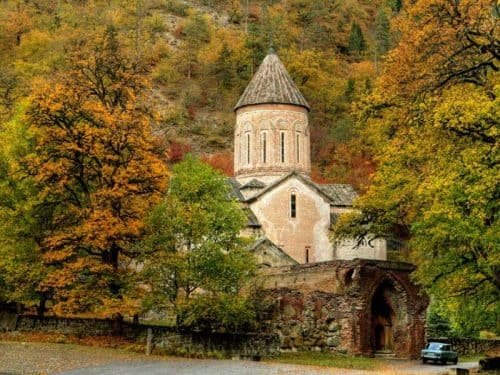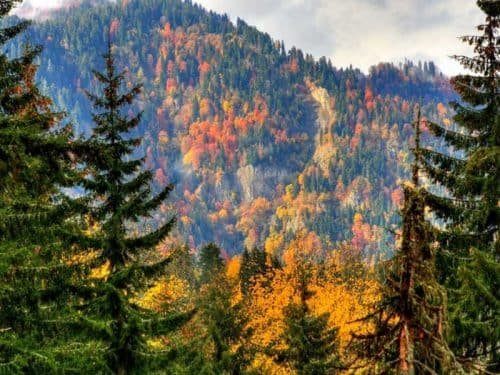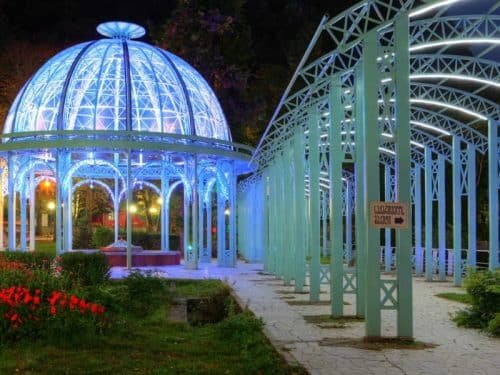Experience a Day Trip from Tbilisi to Borjomi & Bakuriani for Monasteries, Mineral Waters, and Scenic Mountain Views. Refreshing spa culture awaits!
Day Trip from Tbilisi to Borjomi & Bakuriani: Monasteries, Mineral Waters and Mountain Scenery
If you are looking for a refreshing escape from Tbilisi that combines spa culture, medieval monasteries, legends of warrior saints and alpine mountain views, this one–day trip to Borjomi and Bakuriani is the perfect choice. The route includes the celebrated Borjomi Mineral Water Park, the mystical Green Monastery, and the fresco–rich Timotesubani Monastery. Add to that the clean air of Bakuriani ski resort and you have a full day filled with history, spirituality and nature.
Why this route is special
Borjomi is Georgia’s spa capital and one of the country’s most famous brands worldwide thanks to its unique volcanic mineral water. Beyond its springs, Borjomi Gorge shelters monasteries that date back to the 9th and 13th centuries, their walls filled with frescoes and stories of faith, courage and sacrifice.
Further uphill, Bakuriani’s alpine meadows and forests invite a walk, a picnic or simply a pause to breathe deeply. The route is beginner-friendly, paved all the way and combines easy walks with scenic stops.
Tour Program
Borjomi’s Mineral Water Park (Nature’s Gift)
The spa town of Borjomi lies at the confluence of the Mtkvari, Borjomula and Gujaretisckali rivers, surrounded by the Meskheti and Trialeti mountain ranges at 800–900 m above sea level. Historical records mention several villages in this area as early as the 15th–18th centuries. The name Borjomi first appears in 19th–century official sources, likely brought by refugees expelled by the Ottomans from a nearby gorge.
The star of Borjomi is its mineral water, formed more than 1,500 years ago deep underground. Rising 8–10 km below the surface, the water is pushed upward by natural carbon dioxide pressure and emerges still warm, enriched with more than 60 minerals from the Caucasus rock layers. Locals call it “Nature’s Gift” and visitors come from all over the world to taste its slightly salty, therapeutic flavor.
The Borjomi Mineral Water Park, founded in 1850, combines green walking alleys, amusement rides and historic springs. A stroll through the park, tasting water from the original taps, is a highlight of the day.
Green Monastery (Chitakhevi St. George Monastery)
Hidden in a lush valley near Borjomi lies the Green Monastery, founded in the 9th century by Christopher and Tevdore, students of the influential St. Grigol Khandzteli. The monastery complex includes a basilica-type church and a separate bell tower. The name “Green Monastery” comes from the unique color of the valley’s trees and the greenish stones used in the construction, some lighter, some darker, giving the church a distinctive look.
Legends recall tragic times: during invasions in the 16th century, dozens of monks were tortured and killed here. Their blood, it is said, stained the stones that were thrown into the Chitakhevi River, where they can still be seen today as “bloody stones.” Despite this dark history, the monastery radiates peace and has become a place of pilgrimage and contemplation for many visitors.
Timotesubani Monastery (Cathedral of the Holy Virgin)
Located in Borjomi Gorge, the Timotesubani Monastery is a cross-cupola church built between the 12th and 13th centuries. Inside, its walls are covered with some of the finest examples of Georgian mural painting from the 13th century, depicting saints, martyrs and warrior figures. Originally the church had a blue roof—blue was a highly valued color in the Middle Ages—but today it has been restored to a natural stone shade.
According to legend, Georgian warriors Shalva and Ivane Toreli often prayed here before battles. After one victory, they built a church in gratitude to the Virgin Mary. In 1225, during the invasion of Sultan Jalal al-Din, Shalva and Ivane led a desperate defense similar to Thermopylae. Ivane and his soldiers fell, Shalva was captured and offered wealth in exchange for conversion to Islam. He refused, endured torture and became venerated as a holy martyr. Many believe that Shalva inspired Rustaveli’s hero in “The Knight in the Panther’s Skin.”
This combination of history, sacrifice and art makes Timotesubani a deeply moving stop. Visitors often spend time simply admiring the frescoes, searching for depictions of saints and warriors that still speak across the centuries.
Bakuriani (Alpine Air and Mountain Views)
After Borjomi Gorge, the road climbs to Bakuriani, Georgia’s beloved ski resort and a favorite mountain retreat since Soviet times. At 1,700 m above sea level, Bakuriani is surrounded by fir forests and alpine meadows. In summer it offers fresh air, wildflowers and panoramic views; in winter it becomes a snowy wonderland. Even a short stroll here provides a refreshing contrast to the warmer valleys below.
Practical Info for Travelers
- Tour type: Daily trip from Tbilisi.
- Duration: Full day.
- Maximum group size: 35 people.
- Locations: Borjomi Mineral Water Park, Green Monastery, Timotesubani Monastery, Bakuriani.
- Transport: Comfortable vehicle, paved roads, scenic driving route.
Tips for a Smooth Trip
- Bring a refillable water bottle to taste Borjomi straight from the springs.
- Wear comfortable shoes for monastery visits and park walks.
- Dress modestly if entering churches (covered shoulders and knees).
- Carry a light jacket: Bakuriani is cooler even in summer.
- Keep your camera ready: frescoes, valleys and alpine views are unforgettable.
FAQ (Quick and Honest)
Is this trip suitable for families?
Yes, children enjoy the Mineral Water Park and Bakuriani’s fresh air. Monastery visits are calm and educational.
How much walking is involved?
Mostly short walks (10–20 minutes) at each site. Paths are easy, but good shoes are recommended.
When is the best time to go?
Spring and autumn for mild weather and colors, summer for greenery and mountain breezes, winter for snow in Bakuriani.
Get in Touch
If you would like to request more information, please let us know through the contact page. You will be contacted shortly by our staff.
Phones: +995 577 191815 | +995 596 191911 | +995 599 909020


